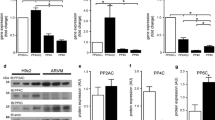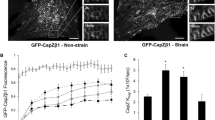Abstract
The present study was conducted to determine the magnitude and duration of ribosomal protein translation in response to pressure overload and determine if additional, paracrine events associated with mechanical transduction, such as integrin activation using a bioactive peptide ligand, RGD or endothelin stimulation lead to ribosomal protein translation. Polysome analysis of ventricular tissue samples obtained from an in vivo model of right-ventricular pressure overload (RVPO) showed a significant shift in the proportion of a 5′-terminal oligopyrimidine (5′-TOP) mRNA, rpL32, associated with the polysomal fraction when compared with non-5′-TOP mRNAs, β-actin and β-myosin heavy chain (β-MHC), in the early stages of the hypertrophic response (24–48 h). Furthermore, this increase in polysome-bound rpL32 mRNA was accompanied by the phosphorylation of mammalian target of rapamycin (mTOR), p70 S6 kinase (S6K1), and S6 ribosomal protein. In our in vitro studies, treatment of primary cultures of adult feline cardiomyocytes (cardiocytes) with 100 nM endothelin, 9 mM RGD, 100 nM insulin, or 100 nM TPA activated mTOR via distinct signaling pathways and resulted in an increased proportion of polysome-bound rpL32 mRNA. Pre-treatment of cardiocytes with the mTOR inhibitor rapamycin blocked the agonist-induced rpL32 mRNA mobilization to polysomes. These results show that mechanisms that regulate ribosomal biogenesis in the myocardium are dynamically sensitive to pressure overload. Furthermore, our in vitro studies indicate that distinct pathways are operational during the early course of hypertrophic growth and converge to activate mTOR resulting in the translational activation of 5′-TOP mRNA.








Similar content being viewed by others
References
Aloni R, Peleg D, Meyuhas O (1992) Selective translational control and nonspecific posttranscriptional regulation of ribosomal protein gene expression during development and regeneration of rat liver. Mol Cell Biol 12:2203–2212
Avni D, Biberman Y, Meyuhas O (1997) The 5′ terminal oligopyrimidine tract confers translational control on TOP mRNAs in a cell type- and sequence context-dependent manner. Nucleic Acids Res 25:995–1001
Balasubramanian S, Kuppuswamy D (2003) RGD-containing peptides activate S6K1 through beta3 integrin in adult cardiac muscle cells. J Biol Chem 278:42214–42224
Caldarola S, Amaldi F, Proud CG, Loreni F (2004) Translational regulation of terminal oligopyrimidine mRNAs induced by serum and amino acids involves distinct signaling events. J Biol Chem 279:13522–13531
Fingar DC, Blenis J (2004) Target of rapamycin (TOR): an integrator of nutrient and growth factor signals and coordinator of cell growth and cell cycle progression. Oncogene 23:3151–3171
Fischer P, Hilfiker-Kleiner D (2007) Survival pathways in hypertrophy and heart failure: the gp130-STAT3 axis. Basic Res Cardiol 102:279–297
Geyer PK, Meyuhas O, Perry RP, Johnson LF (1982) Regulation of ribosomal protein mRNA content and translation in growth-stimulated mouse fibroblasts. Mol Cell Biol 2:685–693
Goldsmith EC, Carver W, McFadden A, Goldsmith JG, Price RL, Sussman M, Lorell BH, Cooper G, Borg TK (2003) Integrin shedding as a mechanism of cellular adaptation during cardiac growth. Am J Physiol Heart Circ Physiol 284:H2227–H2234
Iijima Y, Laser M, Shiraishi H, Willey CD, Sundaravadivel B, Xu L, McDermott PJ, Kuppuswamy D (2002) c-Raf/MEK/ERK pathway controls protein kinase C-mediated p70S6K activation in adult cardiac muscle cells. J Biol Chem 277:23065–23075
Ivester CT, Tuxworth WJ, Cooper Gt, McDermott PJ (1995) Contraction accelerates myosin heavy chain synthesis rates in adult cardiocytes by an increase in the rate of translational initiation. J Biol Chem 270:21950–21957
Jefferson LS, Kimball SR (2003) Amino acids as regulators of gene expression at the level of mRNA translation. J Nutr 133:2046S–2051S
Kaspar RL, Kakegawa T, Cranston H, Morris DR, White MW (1992) A regulatory cis element and a specific binding factor involved in the mitogenic control of murine ribosomal protein L32 translation. J Biol Chem 267:508–514
Kato S, Ivester CT, Cooper Gt, Zile MR, McDermott PJ (1995) Growth effects of electrically stimulated contraction on adult feline cardiocytes in primary culture. Am J Physiol 268:H2495–H2504
Kumar V, Pandey P, Sabatini D, Kumar M, Majumder PK, Bharti A, Carmichael G, Kufe D, Kharbanda S (2000) Functional interaction between RAFT1/FRAP/mTOR and protein kinase cdelta in the regulation of cap-dependent initiation of translation. Embo J 19:1087–1097
Laser M, Kasi VS, Hamawaki M, Cooper Gt, Kerr CM, Kuppuswamy D (1998) Differential activation of p70 and p85 S6 kinase isoforms during cardiac hypertrophy in the adult mammal. J Biol Chem 273:24610–24619
Laser M, Willey CD, Jiang W, Cooper Gt, Menick DR, Zile MR, Kuppuswamy D (2000) Integrin activation and focal complex formation in cardiac hypertrophy. J Biol Chem 275:35624–35630
Lee TM, Lin MS, Tsai CH, Chang NC (2007) Effects of pravastatin on ventricular remodeling by activation of myocardial KATP channels in infarcted rats: role of 70-kDa S6 kinase. Basic Res Cardiol 102:171–182
Levy S, Avni D, Hariharan N, Perry RP, Meyuhas O (1991) Oligopyrimidine tract at the 5′ end of mammalian ribosomal protein mRNAs is required for their translational control. Proc Natl Acad Sci USA 88:3319–3323
Malik RK, Parsons JT (1996) Integrin-dependent activation of the p70 ribosomal S6 kinase signaling pathway. J Biol Chem 271:29785–29791
Manso AM, Elsherif L, Kang SM, Ross RS (2006) Integrins, membrane-type matrix metalloproteinases and ADAMs: potential implications for cardiac remodeling. Cardiovasc Res 69:574–584
Marino TA, Houser SR, Cooper Gt (1983) Early morphological alterations of pressure-overloaded cat right ventricular myocardium. Anat Rec 207:417–426
Marino TA, Kent RL, Uboh CE, Fernandez E, Thompson EW, Cooper Gt (1985) Structural analysis of pressure versus volume overload hypertrophy of cat right ventricle. Am J Physiol 249:H371–H379
McMullen JR, Sherwood MC, Tarnavski O, Zhang L, Dorfman AL, Shioi T, Izumo S (2004) Inhibition of mTOR signaling with rapamycin regresses established cardiac hypertrophy induced by pressure overload. Circulation 109:3050–3055
Morgan HE, Baker KM (1991) Cardiac hypertrophy. Mechanical, neural, and endocrine dependence. Circulation 83:13–25
Nemazanyy I, Panasyuk G, Zhyvoloup A, Panayotou G, Gout IT, Filonenko V (2004) Specific interaction between S6K1 and CoA synthase: a potential link between the mTOR/S6K pathway, CoA biosynthesis and energy metabolism. FEBS Lett 578:357–362
Nobukuni T, Joaquin M, Roccio M, Dann SG, Kim SY, Gulati P, Byfield MP, Backer JM, Natt F, Bos JL, Zwartkruis FJ, Thomas G (2005) Amino acids mediate mTOR/raptor signaling through activation of class 3 phosphatidylinositol 3OH-kinase. Proc Natl Acad Sci USA 102:14238–14243
Pende M, Um SH, Mieulet V, Sticker M, Goss VL, Mestan J, Mueller M, Fumagalli S, Kozma SC, Thomas G (2004) S6K1(−/−)/S6K2(−/−) mice exhibit perinatal lethality and rapamycin-sensitive 5′-terminal oligopyrimidine mRNA translation and reveal a mitogen-activated protein kinase-dependent S6 kinase pathway. Mol Cell Biol 24:3112–3124
Perry RP, Meyuhas O (1990) Translational control of ribosomal protein production in mammalian cells. Enzyme 44:83–92
Pfaffl MW (2001) A new mathematical model for relative quantification in real-time RT-PCR. Nucleic Acids Res 29:e45
Proud CG (2002) Control of the translational machinery in mammalian cells. Eur J Biochem 269:5337
Proud CG (2004) Role of mTOR signalling in the control of translation initiation and elongation by nutrients. Curr Top Microbiol Immunol 279:215–244
Reiter AK, Anthony TG, Anthony JC, Jefferson LS, Kimball SR (2004) The mTOR signaling pathway mediates control of ribosomal protein mRNA translation in rat liver. Int J Biochem Cell Biol 36:2169–2179
Rolfe M, McLeod LE, Pratt PF, Proud CG (2005) Activation of protein synthesis in cardiomyocytes by the hypertrophic agent phenylephrine requires the activation of ERK and involves phosphorylation of tuberous sclerosis complex 2 (TSC2). Biochem J 388:973–984
Ross RS, Borg TK (2001) Integrins and the myocardium. Circ Res 88:1112–1119
Russo LA, Morgan HE (1989) Control of protein synthesis and ribosome formation in rat heart. Diabetes Metab Rev 5:31–47
Ruvinsky I, Sharon N, Lerer T, Cohen H, Stolovich-Rain M, Nir T, Dor Y, Zisman P, Meyuhas O (2005) Ribosomal protein S6 phosphorylation is a determinant of cell size and glucose homeostasis. Genes Dev 19:2199–2211
Ruwhof C, van der Laarse A (2000) Mechanical stress-induced cardiac hypertrophy: mechanisms and signal transduction pathways. Cardiovasc Res 47:23–37
Stolovich M, Tang H, Hornstein E, Levy G, Cohen R, Bae SS, Birnbaum MJ, Meyuhas O (2002) Transduction of growth or mitogenic signals into translational activation of TOP mRNAs is fully reliant on the phosphatidylinositol 3-kinase-mediated pathway but requires neither S6K1 nor rpS6 phosphorylation. Mol Cell Biol 22:8101–8113
Sugden PH (2003) Ras, Akt, and mechanotransduction in the cardiac myocyte. Circ Res 93:1179–1192
Sussman MA, McCulloch A, Borg TK (2002) Dance band on the Titanic: biomechanical signaling in cardiac hypertrophy. Circ Res 91:888–898
Thomas G (2002) The S6 kinase signaling pathway in the control of development and growth. Biol Res 35:305–313
Tuxworth WJ Jr, Wada H, Ishibashi Y, McDermott PJ (1999) Role of load in regulating eIF-4F complex formation in adult feline cardiocytes. Am J Physiol 277:H1273–H1282
van Wamel AJ, Ruwhof C, van der Valk-Kokshoom LE, Schrier PI, van der Laarse A (2001) The role of angiotensin II, endothelin-1 and transforming growth factor-beta as autocrine/paracrine mediators of stretch-induced cardiomyocyte hypertrophy. Mol Cell Biochem 218:113–124
van Wamel AJ, Ruwhof C, van der Valk-Kokshoorn LJ, Schrier PI, van der Laarse A (2000) Rapid effects of stretched myocardial and vascular cells on gene expression of neonatal rat cardiomyocytes with emphasis on autocrine and paracrine mechanisms. Arch Biochem Biophys 381:67–73
Wada H, Ivester CT, Carabello BA, Cooper Gt, McDermott PJ (1996) Translational initiation factor eIF-4E. A link between cardiac load and protein synthesis. J Biol Chem 271:8359–8364
Zhu J, Spencer ED, Kaspar RL (2003) Differential translation of TOP mRNAs in rapamycin-treated human B lymphocytes. Biochim Biophys Acta 1628:50–55
Acknowledgements
We thank Charlene Kerr for her excellent technical assistance. This study was supported by Program Project Grant HL-48788 and by Merit and REAP awards from the Research Service of Veterans Affairs, and Institutional Postdoctoral Training Grant HL-07260 from the NIH (to W.J.T).
Author information
Authors and Affiliations
Corresponding author
Additional information
Returned for 1. revision: 18 June 2007 1. Revision received: 28 August 2007 Returned for 2. revision: 30 August 2007 2. Revision received: 6 September 2007
Rights and permissions
About this article
Cite this article
Tuxworth, W.J., Shiraishi, H., Moschella, P.C. et al. Translational activation of 5′-TOP mRNA in pressure overload myocardium. Basic Res Cardiol 103, 41–53 (2008). https://doi.org/10.1007/s00395-007-0682-z
Received:
Accepted:
Published:
Issue Date:
DOI: https://doi.org/10.1007/s00395-007-0682-z




